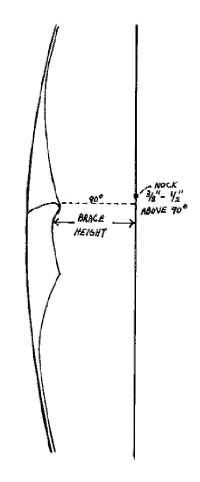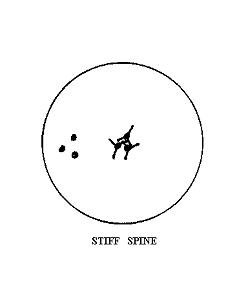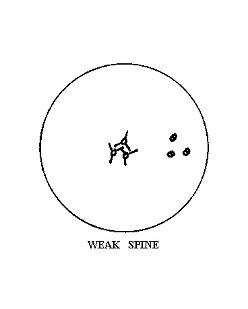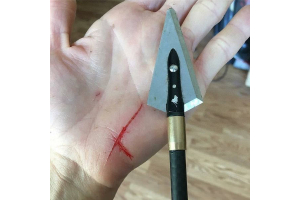|
One of the reasons many folks enjoy shooting traditional equipment is its simplicity. A bow with no mechanical parts that aren't glued on. No set screws, no micro adjustments, and fiberoptic sights, just not much there to go wrong. But you still have to "tune" your equipment if you want to get the best accuracy and performance potential. The methods and techniques for tuning traditional bows is the same as it is with compounds. The same laws of physics apply. The big difference is you don't have the easy adjustments that are built into compounds so other remedies have to be used. The closer to centershot a bow is, the easier it is to tune and the wider range of spines it can shoot well. Just because a bow can shoot arrows at the low or high end of the spectrum, doesn't mean we should accept adequate arrow flight around the edges. Somewhere in the middle of that range is going to be the best arrow spine combination that will be more forgiving of human errors and conditions you are likely to encounter in the field. Taking the time to tune your equipment is time well spent.
The Bell Curve
Take a look at the tuning bell curve. For any given bow, arrow, or archer combination, there will be a "best" arrow that will give the best flight characteristics. To each side of the "best" are arrow combinations that most folks would consider adequate arrow flight quickly dropping off to unacceptable arrow flight. The farther away from the best combination, the more critical a good release and form become. They will shoot great if "I do everything right". The key to tuning is to find that arrow in the middle ground. So...How do we do that? Let's take a look at the shot....
The Shot

There you are, at full draw, your anchor is solid and your back tension is strong, (Fig. A). Something in your mind triggers the release and the string slips from your fingers. As it does so, the string rolls off the fingers and moves slightly to the left for a right handed shooter. No longer is the string and arrow nock lined up with the limbs, it is off center to the left as the energy stored in the limbs accelerates the arrow. This off center rolling off the fingers, off center arrow rest, and force being applied to the nock causes the arrow to bend, first away from your bow arm, (Fig B), then as the power stroke continues, it begins to rebound in the opposite direction, (Fig C), away from the riser. As the arrow clears the bow, it goes through several more cycles of this left and right oscillations, (Figs D,E,F) dampening with each cycle until they cease, and the arrow is finally flying straight as an arrow. No pun intended This bending during the shot is called archers paradox and explains why a bow with no arrow shelf at all can still shoot a properly matched arrow straight, even though it's not even close to the centerline of the bow. Many factors affect this paradox and all must be in "tune" or harmony with each other or bad things start to happen. In a well matched system, these oscillations are equal and cancel each other out so that the arrow stabilizes in line with the direction it was originally pointed. If the arrow is too weak or stiff, the oscillations are unequal, the arrow will swing more to one side than the other, causing the arrow to plane off line in that direction, away from where it was pointed. This mismatched situation may be hardly noticeable with field tips or target points, but broadheads will magnify the problem greatly! Let's take a look at the factors involved with properly tuning your equipment and adjustments to
make that will get them flying correctly.
Arrow Spine
How much the arrow bends during the shot is determined by how much force the bow applies to the back end of the arrow, how far off center the arrow shelf is, how stiff the arrow is (spine), and how clean your release is. Arrow stiffness or spine is measured in pounds and gives you a ballpark guess for matching arrows to your bow. Arrow spine is measured by supporting the arrow in 2 points, 26" apart and hanging a 2 pound weight in the center and measuring how much it bends. For example, if the arrow bends .520 inches, that spines for a 50 pound bow at a 28" draw. Does that mean if you have a 50 pound bow and you buy 50 pound arrows that match and will fly like darts? Not at all! This just gets you to a starting point. Much is left to do and understand before that's going to happen.
A common misunderstanding is confusing arrow spine with arrow weight. They are not related and are two different things. Don't fall for the marketing ploy that so and so's bows are so powerful they require a 10 or 15 pound heavier spine to shoot well. That's a bunch of BS and has less to do with the power of the bow and more to do with how close to center shot the bow is, as we will see later.
Draw Length and Weight
Most bows draw weight is measured at 28" unless marked otherwise. The amount of force applied to your arrow that is going to make it bend is determined by the draw weight of the bow at your draw length. To measure your draw length, draw the bow and have someone mark the arrow on the back side (the side away from you) of the bow or clip a clothespin on the shaft and slide it down the shaft till you reach full draw, then measure from the throat of the nock to that point. This is your draw length. Finished hunting arrows should be at least 3/4" longer than your draw length to provide clearance for your broadhead. A little extra length doesn't hurt anything at hunting ranges and can help in the tuning process later. If the bow is marked 50#@28" and you draw 26", your arrow is not going to see 50 pounds of force. Most bows will increase or decrease about 3 pounds per inch above or below the weight/length it is marked. Now, just because it is marked 50#@28" doesn't mean it is! I have seen them mismarked by 7 pounds or more plus, if you are drawing the bow into the region of the draw force curve where it is stacking, the draw weight can vary more than 3 pounds per inch. If in doubt, you need to get your bow weighed on an accurate scale at your draw length. Arrow length also influences how the arrow behaves, short arrows act stiffer during the shot than long ones, even if their deflection on the spine gauge is the same. A rule of thumb is to add or subtract 5 pounds of spine for each inch above or below 28", and add 5# if you are using a high performance string.
Choosing Arrows
Before we can start tuning, you have to have arrows to shoot. Wood, aluminum, or carbon arrows will shoot well and are a personal choice. The most important considerations with arrows are spine, straightness, and weight. Spine and straightness are of primary importance. 30 or 40 grains weight variation at hunting ranges will make little difference in point of impact so is #3 in importance. At 20 yards, most folks would see little if any difference with 100 grain variation, however.... If the weight variations cause variation in spine, you've got problems. Spine and straightness, however, can not be compromised especially with broadheads. Be aware if you are going to shoot competition that arrow material restrictions may apply in certain classes. The arrow length should be your draw length plus 3/4", but......For tuning purposes, we want to start with shafts about 2" longer than needed in the finished arrow.

Arrows that are going to be shot off the shelf, as most folks do, need to be fletched with 5" or 5 1/2" feathers if broadheads are going to be used, and in either a left or right helical twist. The twist doesn't make any difference but all your arrows should be the same.
Wood arrows are considered by some to be more traditional, especially with longbows but they have their drawbacks. Good wood arrows are not cheap, even more, expensive than aluminum. Building them yourself won't help much if you are as picky with them as I am. If I get 18-24 arrows out of 100 shafts, I'm lucky. First, they must be matched closely in spine and weight, second, they must be straight, and third, they must be sealed well so they do not warp from moisture! A source I recommend for quality wood arrows is Old South Traditional Arrows.
Aluminum arrows are great, with very straight and consistent spine. Spending a little more on XX75 or XX78 shafts will save you money in the long run as they do not bend or break as easily as cheaper aluminums. Carbons are straight, tough, and can be expensive! Lots of people really like them. For the safety of your bow and to absorb enough energy from your bow, your arrows need to weigh 8 to 10 grains per pound of draw weight. Up to 12 or 14 grains/pound for hunting larger game. This can be a problem with carbon arrows and some aluminum. Weight may need to be added or a different arrow chosen.
Initial Bow Setup
 First it must be understood that ANYTHING you do to the bow affects tuning so it is important to set the bow up EXACTLY the way you intend to use it. If you tune your bow and then later add a bow quiver, it changes the tuning, change string silencer styles or position, changes the tuning, adding limb covers or tip protector, changes the tuning.......Granted some changes are so minor that we aren't good enough shots to detect but the changes are there nonetheless. Several tiny changes can add up to take a good shooting bow to poor and you scratch your head wondering why? So, if you are going to hunt with a quiver, put it on, and fill it full of arrows, minus one....Exactly the way it will be when that trophy buck comes to visit.... String silencers put them on...In most cases, place the silencers at the 1/4 points. Measure from where the string just touches the limb to the other point where it just touches the limb, divide by 4, and place the silencers there. First it must be understood that ANYTHING you do to the bow affects tuning so it is important to set the bow up EXACTLY the way you intend to use it. If you tune your bow and then later add a bow quiver, it changes the tuning, change string silencer styles or position, changes the tuning, adding limb covers or tip protector, changes the tuning.......Granted some changes are so minor that we aren't good enough shots to detect but the changes are there nonetheless. Several tiny changes can add up to take a good shooting bow to poor and you scratch your head wondering why? So, if you are going to hunt with a quiver, put it on, and fill it full of arrows, minus one....Exactly the way it will be when that trophy buck comes to visit.... String silencers put them on...In most cases, place the silencers at the 1/4 points. Measure from where the string just touches the limb to the other point where it just touches the limb, divide by 4, and place the silencers there.
Your arrow rest? Extremely important for good arrow flight. Shoot off the shelf or use an elevated rest. Really it's a personal choice but as a rule, instinctive shooters like to have the arrow as close to the hand as possible, which means shooting off the shelf. Many gap/point of aim shooters prefer an elevated rest. Either way, the point your arrow contacts the bow should be directly above the pressure point/low point in the grip. Many arrow shelves are not designed to do this so you need to build up the shelf with layers of leather, the rug side of Velcro, or something to get the contact point in the correct place. See the figure below:
 |
If the contact point is in front of or behind the low point in the grip, it makes the bow less forgiving to torque. It creates an underdraw or overdraw condition. They can be shot well that way with good form but they can be shot better if the contact point is in the proper place. The shelf material should provide some cushioning. The rug side of Velcro works well as does seal skin or spongy leather. Your side plate in the sight window should be as thin as possible getting your arrow as close to center as possible.
Next, set the brace height at the low end of the bowyer's recommendation, just twist or untwist the string to set the brace height. Install a nock point 1/2" to 3/4" above 90 degrees. Now with arrows that you think are going to be close to the correct spine and weight, take the bow out and start shooting it. If the string is new, you want to run 75 or 100 arrows through it just to stretch the string until it settles. Re-adjust the brace height to the low setting again if necessary. Shoot 3 or 4 arrows and pay attention to any hand shock, vibration, and noise. Put 4 or 5 twists in the string and shoot 4 or 5 more arrows, again paying attention to vibration and noise. Keep doing this until the bow starts shooting smoothly and quietly, if you go above this brace height, it will start getting noise and vibration again so drop back down. Once the best brace height is found, measure it and write it down somewhere so if you change strings or the string stretches more, you can re-adjust it without going through this process again. Now we can get to some serious tuning.
TUNING METHODS
There are several tuning methods out there, however, in my opinion, the bare shaft "Planning" method or the broadhead planning method is the best, and here is why.......In a well tuned/matched bow arrow and archer combination, fletching on the shaft isn't needed at all with target points. The arrow balances forward of the center so if launched in a perfectly straight line, the tail of the shaft will follow the point. Fletching on the shaft has one purpose...to counteract and stabilize errors in the shaft's flight path caused by not being launched straight. Not being launched straight can be caused by equipment tuning or flaws in our form and it's difficult to tell the two apart. The goal here is to eliminate equipment flaws leaving only our own poor shooting as an excuse! How can you fine tune your bow and arrows with fletching on the shaft designed to correct and hide flaws?! You can't! Remember the bell curve above? You can get inside the acceptable range by luck or trial and error but our goal is the middle. The broadhead planning method works the same way, broadheads, the bigger the better, magnifies the tuning problems so you can see them and correct them.
The key ground rule in tuning is to only change one variable at a time, and then analyze the results. If you change two or more variables, and your arrow flight gets a little better or worse, you don't know which change caused the results which creates even more confusion. Your shooting form must be fairly consistent, if not, erratic arrow flight will occur even with a properly tuned bow. That doesn't mean you have to be a great shot, as long as you can shoot a "group", you'll be able to determine needed changes and get closer to perfection. Lastly, never make adjustments based on the flight of just one arrow, base your adjustments on the average between several arrows, especially wood arrows where spine consistency and straightness can be a problem. Basing your adjustments on the average of many arrows helps remove the flaws in our form leaving only equipment problems.
The detailed descriptions below are for a right-handed shooter. Up and down adjustments with the nock point are the same if you are right handed or left handed. Left or right adjustments however are reversed. For explanation purposes, all discussions will be for right handed shooters. If you are left handed just reverse all left/right indications.
BARE SHAFT PLANNING
Somehow, bad information has been passed down from archer to archer for many years on the correct method to bare shaft tune. Some might be familiar with, or heard of a technique of bare shaft testing that requires getting close to your target and analyzing nock left/right/up/down patterns for tuning purposes, that is not a good method and causes great confusion! The correct way is bare shaft "planing", or determining adjustments based on bare shaft groups in relation to identical fletched shafts at longer distances. As stated above, an arrow balances forward of center, and if everything is perfect, fletching is not required for accurate arrow flight. A well tuned shaft always goes where it's pointed, fletched or not.
To get started, it's easiest if you have at least several close to correct sized shafts from the chart and several above and below the recommended size also. That is not always possible so let's just say you only have the recommended size from the chart. Your bow should be set up exactly the way you intend to hunt with it. All silencers installed, brush buttons, arrow rest, bow quiver, etc.... Install field tips of the same weight as the broadheads you want to shoot if you have a choice. If you are stuck with only one size shaft, you may be forced to shoot tips heavier or lighter than you desire. NEVER BARE SHAFT BROADHEADS! Field tips/target points only. Broadheads will act like fletching on the wrong end and wild flight can result.
Now to get started, step back 15 or so yards and start shooting 3 or 4 bare shafts mixed with 3 or 4 identical fletched shafts aiming for a spot. Odds are they are not going to fly very well so we need to start making adjustments to straighten them out. You are going to make adjustments based on where the groups are in relation to eack other, not on whether the nocks are kicking one way or another. We want to take care of any up/down problems first. If the majority of your bare shafts are grouping high or low of where the majority of your fletched arrows are, the nock point needs to be adjusted. Ignore left and right problems at this time. If your bare shafts are grouping lower than your fletched shafts, lower your nock point a tiny bit, maybe 1/32" and shoot several more arrows. If you lower your nock point all the way to zero and they are still hitting low, your nock point was too low to start with and the back of the arrow is "kicking" off the shelf, giving a "low" indication! If they impact (group) higher, raise your nock point.
Once your bare shafts are grouping close up/down with the fletched shafts, it's time to work on any left/right problems. If the majority of your bare shafts are impacting (grouping) left of the majority of your fletched shafts, your arrows are too stiff. To correct this you have several options. The easiest is to increase point weight one step and try again. It's possible you may have to go from a 125gr tip to 190gr to get good flight! Another option if you have a thick side plate on your arrow shelf in the sight window is to reduce the thickness of that side plate, move the arrow closer to center shot, and test again. It's also possible you may never get good flight if they are way too stiff and you will be forced to get new shafts of a weaker spine. Hopefully, that won't be the case. If the majority of your bare shafts impact (group) right of your fletched shafts, they are too weak. Reduce your tip weight and try again, or build out your side plate further away from center shot. You can shorten your arrows 1/2" at a time which will make the arrow stiffer. Again if the problem can not be corrected, new shafts of a higher spine may be needed. Remember to never base adjustments on one or two shots, shoot many shots mixing bare and fletched shafts, and average the relationship between the groups. For example, if 5 bare shaft shots went left of the fletched shafts, and one went right, adjust for a shooting left indication. Change only one thing at a time and evaluate the results. Changing from a 2018 to a 2117 for example is TWO CHANGES, not one! You have changed spine and center shot!
Any changes you make to the bare shafts make the same changes to the fletched shafts! The bare and fletched shafts must be identical.
Once you are getting fairly satisfied, step back to 20 yards and start shooting several fletched shafts and bare shafts....Repeat the tuning process starting with nock point adjustments.
A properly tuned setup, bare shafts, and fletched shafts will group together out to 30 yards or more. Expect the bare shaft groups to be somewhat larger than the fletched groups for obvious reasons! The better your form is, the tighter the groups will be and the farther away you can maintain good groups, and finer tuning can be accomplished. The most forgiving arrow to shoot will actually show a slightly weak/slightly high nock point indication. In other words, at 20 yds or more, bare shafts grouping a little low and right is perfect because fletching makes a shaft react slightly stiffer. Totally confused? Here is an overview:
BARE SHAFTS GROUPING HIGH
Reason: Nock point too low
Remedy: Raise nock point |

|
|
BARE SHAFTS GROUPING LOW
Reason: Nock point is too high
Remedy: Lower nock point
|

|
|
BARE SHAFTS GROUPING LEFT
Reason: Over spined (stiff)
Remedy: Heavier point, thinner side plate, or longer shaft, or switching from a Dacron string to a DF-97 or Fast Flight, or new, weaker arrows.
|

|
|
BARE SHAFTS GROUPING RIGHT
Reason: Under spined (weak)
Remedy: Lighter point. or thicker side plate, or shorter shaft, or switch from a DF-97 or FF string to Dacron, or new, stiffer arrows.
|

|
I can't emphasize this point enough......Make one small change at a time and evaluate the results. If things got worse, you went the wrong way!
Fine Tuning Broadheads
For the hunter, this is the bottom line, broadheads that fly true and straight where you look every time! It would be nice to think that with all the tuning you have done to this point you could just glue on matching weight broadheads and get perfect arrow flight, that rarely happens but you should be close! The blades of a broadhead try to plane and steer the arrow so any small tuning problems that were not detected prior will be magnified greatly. I can't emphasize enough how important it is to shoot your broadheads and correct any flight problems BEFORE YOU GO HUNTING WITH THEM! After tuning and practicing with your broadheads, be sure to re-sharpen them to a razor edge.
The first step in tuning your broadheads is to go through the tuning process for your field tips, next is installing the broadheads. Straightness is a must, spin them on a flat table or in a cresting jig to check for wobble. You can spin them on the tip but the very tip can be filed slightly off center showing a wobble that won't cause a flight problem or vice versa.
In theory, the orientation of the blades to the fletching or your sight window should make no difference but.... I feel they should at least all be the same from arrow to arrow and I mount 2 bladed heads horizontal and 3 bladed heads "V" up. I do this for two reasons, most folks mess up a release more often than any other mistake. This results in more side to side "kick" than normal and a 2 bladed heads mounted horizontal will not plane as badly, arrow rotation due to helical fletching starts slowly so the arrow is flying for several feet before full rotation starts. The other reason I mount my heads this way is I don't like anything sticking up into my sight picture that isn't there normally when I'm practicing with field tips. Let's get shootin'...
Get back 20 or so yards from a suitable broadhead target and start shooting field tips and broadheads. Our goal here is to get your broadheads and field tips grouping in the same spot. If they don't, you will try to make adjustments in you "aiming" depending on which arrows you are shooting and that won't happen with a case of buck fever! Take a look at the diagram below:
If most of your broadheads and field tips are grouping together, but one broadhead strays once in a while, check to see if it is the same one that strays. Look for a misaligned broadhead, nock, or bent shaft. If it's a different arrow each time that strays, slightly increase your brace height with 2 or 3 twists in your string, make small adjustments here, it usually doesn't take much. If that doesn't work, decrease the brace height slightly. A brace height adjustment usually gets rid of occasional flyers and small spine problems caused by tuning, but won't do much for the "human" caused flyers, however.
If all your broadheads are grouping together but somewhere other than with your field tips, slight nock point changes and spine changes will bring them in. Make all adjustments one at a time and small, and evaluate the results before making more changes. If you make a change in something and things get worse, put it back and go the other way! If most of your broadheads are shooting stiff and a brace height change doesn't work, adding a touch of lead in front of a short wood taper or broadhead adapter should fix it, or arrows a 1/2" or so longer will soften them a little. For weak indications, going from a long broadhead adapter to a short will knock off a few grains, and shortening the shaft if it's a little too long will stiffen it up a little too.
Once you get them grouping together at 20 yards, if you want to fine tune even better, wet the feathers of your broadheads until the feathers are matted down, and repeat the process! Having that huge buck show up with matted feathers after a rain storm is not the time to find out you have tuning problems!
Now, what do I do?
First, measure your brace height and nock point height, and write them down somewhere. This will save you tremendous time later on. It's also not a bad idea to take that string off and use it as a spare. Get another identical string, set it up, and go through the tuning process again. Next, practice, practice, practice, sharpen those broadheads and go hunt something!
Tuning is essential to get the best accuracy and performance out of your bow. Most of this is science and the better you understand the relationships and the cause and effects of all the variables, the easier it is. I hope this information will help you enjoy archery even more and remove any doubts about your equipment, putting the excuses for missing where they should be, on the shooter!
Ready to test a High FOC arrow system for yourself? Learn why we recommend starting with a two-arrow test pack.
|




 First it must be understood that ANYTHING you do to the bow affects tuning so it is important to set the bow up EXACTLY the way you intend to use it. If you tune your bow and then later add a bow quiver, it changes the tuning, change string silencer styles or position, changes the tuning, adding limb covers or tip protector, changes the tuning.......Granted some changes are so minor that we aren't good enough shots to detect but the changes are there nonetheless. Several tiny changes can add up to take a good shooting bow to poor and you scratch your head wondering why? So, if you are going to hunt with a quiver, put it on, and fill it full of arrows, minus one....Exactly the way it will be when that trophy buck comes to visit.... String silencers put them on...In most cases, place the silencers at the 1/4 points. Measure from where the string just touches the limb to the other point where it just touches the limb, divide by 4, and place the silencers there.
First it must be understood that ANYTHING you do to the bow affects tuning so it is important to set the bow up EXACTLY the way you intend to use it. If you tune your bow and then later add a bow quiver, it changes the tuning, change string silencer styles or position, changes the tuning, adding limb covers or tip protector, changes the tuning.......Granted some changes are so minor that we aren't good enough shots to detect but the changes are there nonetheless. Several tiny changes can add up to take a good shooting bow to poor and you scratch your head wondering why? So, if you are going to hunt with a quiver, put it on, and fill it full of arrows, minus one....Exactly the way it will be when that trophy buck comes to visit.... String silencers put them on...In most cases, place the silencers at the 1/4 points. Measure from where the string just touches the limb to the other point where it just touches the limb, divide by 4, and place the silencers there.
















